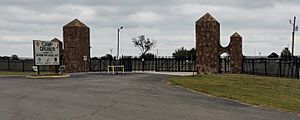Camp Gruber facts for kids
Quick facts for kids Camp Gruber Training Center |
|
|---|---|
| Part of Oklahoma National Guard United States Army |
|
| Muskogee County, near Braggs, Oklahoma | |
 |
|
| Coordinates | 35°40′34″N 95°11′13″W / 35.67611°N 95.18694°W |
| Type | National Guard Training Center |
| Site information | |
| Owner | U.S. Federal Government |
| Controlled by | Oklahoma Military Department, (OMD) |
| Open to the public |
Prior Permission needed |
| Site history | |
| Built | 1942 |
| Built by | United States Army |
| In use | 1942-1947 1967-Present |
| Battles/wars | World War II, Cold War |
| Garrison information | |
| Garrison | Braggs, Oklahoma |
| Occupants | Oklahoma Army National Guard |
Camp Gruber is a large training area for the Oklahoma Army National Guard (OKARNG). It covers about 87 square miles (225 square kilometers) of land.
The camp is named after Brigadier General Edmund L. Gruber. He was a famous artillery officer. He also wrote the original music for the U.S. Field Artillery March, which became the official song of the Army, "The Army Goes Rolling Along".
Camp Gruber is located near Braggs, Oklahoma in the Cookson Hills. It's about 14 miles (22 kilometers) southeast of Muskogee, Oklahoma. The Oklahoma Wildlife Department and the OKARNG have an agreement. This allows people to hunt on the base in certain areas.
Contents
History of Camp Gruber
Why Camp Gruber Was Built
When World War II started in Europe in 1939, the United States began to get ready for war. President Franklin D. Roosevelt wanted to make the military stronger. By 1940, Congress approved more money for building military camps and factories.
The U.S. Army had plans to grow from 200,000 soldiers to six million. They needed many new training camps. Oklahoma was a good place for these camps. It had a good location, climate, natural resources, and many available workers. So, the War Department decided to build an infantry training camp near Braggs.
Building the Camp
In 1935 and 1936, the U.S. Department of Agriculture bought a lot of farmland in eastern Oklahoma. More land was bought later, including some from the Cherokee Nation. Farmers living on this land had to move.
In 1942, the entire area came under the control of the War Department. The Cookson Hills Project was designed to be a training center for soldiers. The camp ended up covering between 60,000 and 70,000 acres (about 109 square miles or 282 square kilometers).
Construction began in early January 1942. Engineers from the U.S. Army Corps of Engineers started setting up headquarters. In February 1942, the camp was named "Gruber."
A company called Manhattan-Long Construction Company won the bid to build the camp. They had to build 1,731 buildings very quickly. These included barracks for soldiers, hospital buildings, offices, chapels, and recreation halls. They also built a water system from Greenleaf Lake. New roads, sewer, gas, and electrical systems were also put in place. The company even moved Highway 10 around the base.
Construction moved very fast through May 1942. The first official order for the camp was given on May 21.
Training at Camp Gruber During World War II
During World War II, Camp Gruber trained many different types of soldiers. These included infantry (foot soldiers), field artillery (soldiers who use big guns), and tank destroyer units. These soldiers went on to fight in Europe.
Several important units trained at Camp Gruber. The 333rd and 969th Field Artillery Battalions trained here. They fought bravely from Utah Beach until the end of the war. They even earned a special award called the Presidential Unit Citation. The 88th Infantry Division ("Blue Devil Division") also trained at Gruber.
In 1943, the 42nd Infantry Division ("Rainbow Division") was restarted at Camp Gruber. Later, in 1945, the 86th Infantry Division ("Blackhawk Division") was stationed there.
More than 44,868 troops either served or trained at Camp Gruber during the war. The camp also employed four thousand civilian workers. About three thousand German prisoners of war were held at a separate facility near the base. These prisoners built beautiful monuments and brick-lined drainage canals. Their work is still strong today. Camp Gruber was a key training base for the U.S. Army until the end of World War II.
After the War
On June 3, 1947, Camp Gruber was closed down as an active military base. Most of the land became surplus property. The federal government kept control of the land.
During the 1950s and 1960s, most of the original buildings at Camp Gruber were taken down or destroyed.
In 1967, the Oklahoma Military Department and the Oklahoma Army National Guard (OKARNG) took over a large part of the land. They wanted to use Camp Gruber as a state-operated training area. More land was added in 1973 and 1982. Today, Camp Gruber continues to be an important training facility for the Oklahoma Army National Guard.

